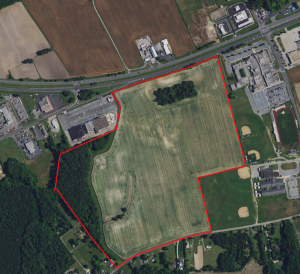Absence of funding plan not seen as impediment to purchase of property
Despite not having a funding mechanism to produce the $7.15 million needed to buy a 95.6-acre parcel on Route 50 for a sports facility site, the Worcester County Commissioners will continue to move forward with a study to get the ball rolling on the project.

PHOTO COURTESY WORCESTER COUNTY COMMISSIONERS AGENDA PACKET
Worcester County Commissioners, in a 4-3 vote, agreed to pay over $28,000 to an engineering firm to assess potential locations to access Route 50 from a proposed sports complex location, located just west of Stephen Decatur High School, on the roadway also known as Ocean Gateway.
In a 4-3 vote, the commissioners agreed to spend $28,523.62 to have the engineering firm Wallace Montgomery evaluate access options from the site to Route 50. The firm’s findings would then be presented to the district office of the State Highway Administration office for review.
Commissioners Chip Bertino, Ted Elder, and Jim Bunting opposed the measure.
The property is located just west of Stephen Decatur High School along Route 50, and in July it was revealed that money bonded for cannot be used to purchase the parcel, as originally planned. The purchase is being disputed by a group of petitioners in Ocean Pines which collected enough signatures to challenge the acquisition at referendum in November.
Chief Administrative Officer Weston Young introduced the proposal to the commissioners, which Bunting immediately called unnecessary when the county does not own the property or know what the outcome will be in November when residents head to the polls and vote on whether to purchase the parcel.
“A simple call can find out if an access point is possible,” the commissioner said, suggesting a call to local SHA office be made instead of spending nearly $29,000.
Bunting also said it was going to be difficult to add access points with merging lanes and traffic near Stephen Decatur High School, according to the SHA representatives with whom he already spoke. But with guidelines for intersections and guard rails, Bunting said he thinks the state agency can give a fairly good idea on whether an access point is possible, without spending the money.
Bertino asked Young whether discussions had taken place between the county and Berlin officials and was told they had not. Bertino also asked if the discussions will eventually take place, especially since some people are concerned about the location.
Like Bunting, Bertino asked why the county cannot just pick up the phone and get an answer instead of spending $29,000.
Young told the commissioners that the local office could give an answer on where potential access points could be located, but those points could be overturned by officials in the main SHA office in Baltimore.
He also said the study will give the county concept plans to be able to share with Berlin officials for potential future discussions.
Commissioner Bud Church, on the other hand, told the other commissioners that the $28,000 is “just pennies” and this was just one step in the process. Church then moved to approve the study, which was agreed on by Commissioners Josh Nordstrom, Joe Mitrecic, and Diana Purnell.
Before the commissioners discussed the access points, Young told them that the Phase 1 environmental assessment requested after the April 19 public hearing – which is when the commissioners voted to enter a contract on purchasing the property with bond money – was completed by John D. Hynes and Associates.
The assessment was conducted to investigate existing or potential contamination on the property and is required before the county can complete the purchase.
Young said the study is “high level,” meaning it looks at prior uses of the site and seeks any recognized environmental conditions there.
“To summarize, there were no recognized environmental issues on the site,” he said.
Had there been, a Phase 2 study would need to be conducted that includes taking soil samples wherever any known possible spills or tanks were located.
Young added that there were potential environmental conditions on adjacent sites in connection with unknown quantities of petroleum that was released on those properties.
The firm was not sure whether the sites were cleaned up properly, Young said, and it recommended doing sample sites between the locations because of the absence of any paperwork on those possible incidents.
The commissioners did not discuss the assessment any further and no action was taken on whether to move forward with the soil samples.
